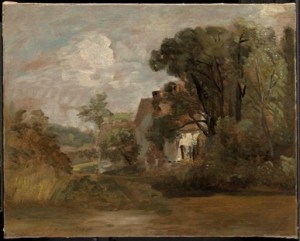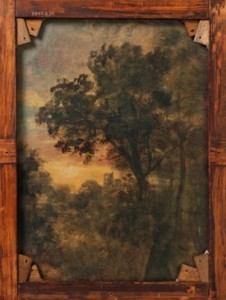
John Constable, Willy Lott’s House (recto), c. 1812–13. The Clark. Gift of the Manton Art Foundation in memory of Sir Edwin and Lady Manton
(WILLIAMSTOWN, Mass..) — A painting is a three-dimensional object, but often visitors to art museums are only privy to one aspect, and thus are deprived of the whole story the artwork can tell. In the Sterling and Francine Clark Art Institute’s exhibition Backstories: The Other Side of Art, the hidden aspects of works of art are exposed, revealing when and how they were made, how they have been cared for by collectors, and the many changes they have undergone. Spanning five centuries, the exhibition includes paintings, works on paper, sculpture, silver, and porcelain. Most of the objects in the exhibition will be displayed on pedestals, allowing visitors to view them from all sides. Special inscriptions and other details that may have gone unnoticed in a typical exhibition setting will be highlighted. Backstories is on view at The Clark from December 22, 2012 through April 21, 2013.
“Backstories literally looks at objects in the Clark’s collection from both sides,” said Clark director Michael Conforti. “The acquisition of a two-sided painting by Giovanni Battista Cremonini spurred our interest in the backs of other objects in our collection. As the curatorial team began to think about the objects in a different way, Backstories was born.”
According to Camran Mani, curator of the exhibition and former curatorial associate at the Clark, “Often we think of works of art as images on a computer screen or a postcard, but Backstories reminds us that they are real, tangible objects with stories to tell. Those stories are not always obvious when one looks at the front of a painting, drawing, or decorative object, but examining them as three-dimensional objects, turning them over and inspecting the back or the bottom, allows us to unlock some of those secrets.” Mani received his M.A. from the Williams College Graduate Program in the History of Art in 2011 and is currently a Ph.D. candidate in History of Art and Architecture at Harvard University. Backstories is on view at the Clark December 22, 2012 through April 21, 2013.
Time and place. A pair of sixteenth-century oil paintings on panel shows how the back of an object can yield important clues as to how, when, and by whom it was created. Portrait of a Gentleman (c. 1530), attributed to Jan Gossaert, and Lucretia (1534), artist unknown, were originally painted on two sides of a single panel. At some point before entering the Clark’s collection, the panel was split in two, creating two distinct works.

John Constable, Landscape Sketches with Trees and Church Tower (verso), c. 1811–13. The Clark. Gift of the Manton Art Foundation in memory of Sir Edwin and Lady Manton
It has been assumed that the “front” side, a portrait of a lavishly dressed sitter who was possibly associated with the court of the Duke of Burgundy, was painted by Gossaert. However, the reverse of the painting is dated 1534, two years after Gossaert’s death, bringing into question the attribution of both sides of the painting. The reverse of the painting also reveals important information about preservation and artistic practice in sixteenth-century Flanders. During this period, panels were often painted on both sides to protect the wood from moisture and worm damage. The figure of Lucretia is painted in grisaille — tones of gray that simulate the appearance of sculpture — perhaps to spare the expense of costly pigments and to emphasize the antique origins of Lucretia’s story. According to legend, Lucretia’s rape and suicide helped spur the revolution that established the Roman Republic.
Vision and practice. The back of a work of art can give insight into the process of artistic creation. Giorgio Morandi’s graphite drawing Still Life with Bottle (1949), inspired by the still lifes of Paul Cézanne, explores subtle and expressive formal arrangements. The reverse of the drawing shows a similar composition and sheds light on the artist’s experimentation with size and placement of the objects.
John Constable is best known for his landscape paintings that celebrate the rural beauty of Suffolk, his childhood home. Willy Lott’s House was one of many studies Constable made in preparation for The Ferry, a six-foot painting he exhibited at the Royal Academy in 1814. The loose brushwork in the sky and staccato handling of the leaves on the right suggest that the study was done outdoors. The reverse of this canvas bears other oil sketches that Constable painted in a vertical orientation, layered atop one another. One sketch is a barely visible landscape, with hills in the middle distance and a small tree on the right. After abandoning this sketch, Constable probably turned the canvas over to work on the other side — the “front” that became Willy Lott’s House — and returned at a later date to paint the clearer, vertical composition Landscape Sketches with Trees and Church Tower, which includes a large tree in the foreground.
Past and present. The back of an object can be the source of fascinating information about its past. The reverse of Peter Paul Rubens’s Portrait of Thomas Howard, Earl of Arundel identifies the sitter and provides information relating to its collection history. An inscription records that the sketch was bought in 1779 at the “Hudson Sale,” the auction of the collection of the artist Thomas Hudson. Below, another inscription clarifies that the initial inscription was by Lord Selsey “at whose sale in 1872 at Sotheby’s this drawing was bought.” This secondary inscription was signed by the purchaser, Robert Prioleau Roupell, who also identified the sitter as the Earl of Arundel. After Roupell’s death, the sketch was acquired by a private collector before being purchased in 1926 by Sterling and Francine Clark.
A silver milk jug (1765–66) by Daniel Smith and Robert Sharp, engraved with the names of the many owners of the piece, tells a remarkable story of friendship and hope. Dr. John Fothergill, a London physician, originally presented the jug to his friend Benjamin Franklin, who in turn left it to another friend in his will, thereby beginning a custom of passing the jug from friend to friend. The inscription “KEEP BRIGHT THE CHAIN” presumably refers to the friendship between Fothergill and Franklin and their shared hope of preserving the links between Britain and the American colonies. To see all of the inscriptions, it is necessary to view the jug from all angles, including the bottom.
Muse and motif. Backstories also includes a small suite of pictures in which modern artists, including Henri de Toulouse-Lautrec, Edgar Degas, and Alfred Stieglitz, present images in which the subjects have their backs to the viewer. The exhibition also marks the public debut of a Stieglitz photograph recently acquired by the Clark. An icon in the history of modernist photography in America, The Terminal represents a streetcar driver seen from behind, watering his horses on a wintry day in New York City in 1893. The photograph was a gift to the Clark from the family of Stieglitz’s dermatologist, Dr. Moon Adams, who received it in appreciation from the photographer.
The Clark is located at 225 South Street in Williamstown, Massachusetts. The galleries are open Tuesday through Sunday from September through June (daily in July and August), 10 am to 5 pm. Admission is free November through May; free year-round for Clark members, children 18 and younger, and students with valid ID; and $15 June 1 through October 31. For more information, call 413 458 2303 or visit Sterling and Francine Clark Art Institute.
